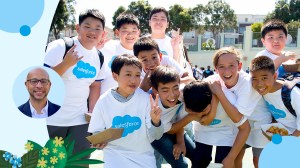Schools today are under a massive amount of pressure as they try to recover lost learning and address mental health impacts that resulted from the pandemic.
Educators are getting creative, though, and new learning strategies have the potential to expand opportunity and address historic inequities.
Ron Smith brings 20 years of public education experience — and a resulting understanding of what educators face — to his role as Vice President of Philanthropy at Salesforce. In this conversation, Smith shines a light on how the company’s partnerships with school districts aim to support educators and institutions as they navigate these waters — both now and in the future.
Q: How does your background in education help inform Salesforce’s philanthropy strategy?
My role at Salesforce is focused on strategic giving initiatives that strengthen education systems while also addressing racial equality, justice, and economic opportunity, finding throughlines to support students and their families.
My background provides perspective on the challenges our communities face and how they are interconnected. I spent 20 years in the Oakland public school districts before coming to Salesforce. I was a teacher, an elementary and middle school principal, a middle school network superintendent, and then assistant superintendent supervising a K-12 school transformation in Oakland.
This experience has helped me build trust with school districts, understand the gaps in funding, and learn how Salesforce can be a partner in the work of supporting education and career readiness through philanthropy.
Q: How does Salesforce partner with public school districts to support high-impact programs?
We always start with a simple question: How can we help? At the heart of it, we work side by side with districts to understand their greatest needs and the unique ways that we can contribute.
We always start with a simple question: How can we help?
RON SMITH
Over 10 years ago, our CEO made a commitment to champion public education. We’ve continued to expand our partnerships in education over time and now have given more than $146 million globally to this cause. We’ve also built deep relationships that go beyond just funding. We bring our employees to volunteer, we provide technology, and we stay in constant contact to learn how we can help when there’s new challenges.
Our philanthropy strategy is always evolving as the needs of our partners change. For example, we’ve been hearing from our partners that mental health is one the most pressing issues facing students, so that’s been the focus of a few of our new initiatives.
We’re working with the Oakland Unified School District to provide counselors for middle school students who are newcomers to the United States. Counselors provide support, not just for academics, but also to help students navigate unique challenges and transition to high school.
Q: Which trends shaping the education landscape are helping to guide Salesforce’s giving strategies?
First, embracing multiple ways of learning. Teachers had to throw away the traditional book during the pandemic. There are still national and state standards that schools have to meet, but how schools implement those standards has had to change. It’s forced innovation and creativity. Teachers are saying, “Let’s get different. Let’s be creative. Let’s try new things, and let’s take what’s working and hold on to it moving forward.” Those that have been successful early in building new systems for virtual and in-person learning will share those learnings. We will never again see education the way it was before the pandemic.
Prioritizing social emotional learning and mental health. A challenge that COVID has highlighted is the need to prioritize both social-emotional learning and mental health. When young people were isolated for 18 months, they didn’t have the same opportunity to develop their social-emotional skills, and mental health issues also accelerated. We’re moving into a new phase of the pandemic, but these problems aren’t going away, and we’re going to have to address them first if we’re going to address academics.
Expanding early training opportunities for different career pathways. Go to high school, graduate, go to college, get a degree, and then get a job — that’s not the system for everyone. There has to be multiple pathways to a career. I’ve heard again and again from our partners the need to start earlier access to job preparedness training and an emphasis on expanding the pathways for students to be prepared to enter the workforce.
Using technology and data to support students holistically. Resources like computers and the internet are of course critical, connecting those in-person and virtually, and opening up opportunity and access. There’s fear around data, but it’s shown that it can be a beneficial tool for teachers, students, and families. Data allows schools to build stronger programs and support students as they grow.
Last, but not least, addressing long-standing inequities. If we don’t change how we’re doing things, the inequities that were already there before COVID will continue to grow. At Salesforce, we’re focused on working with our partners on more concentrated efforts to expand access and opportunity for African American and Latinx populations in the United States and women in various countries around the world who face more barriers to education and job opportunities.
Q: How can individuals and companies support educators during Teacher Appreciation Week and beyond?
Grit, passion, power, resilience. Pick whatever term you want to use to describe someone who is a true champion, that’s what educators are. The hardest profession in the United States is teaching. Period. Teachers deserve to be thanked every day.
Our students and teachers can benefit from all of us getting involved – whether or not you have a child in the system. Start by doing your research, understand what is going in your district, the depth of the work, and the gaps you can fill. And show your gratitude for teachers every day.
More information:
- Read about Salesforce’s commitment to education and its latest investments in public school districts and education nonprofits.














